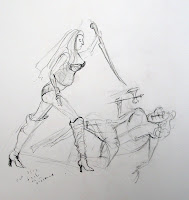
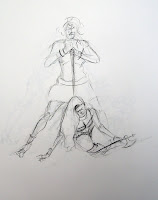
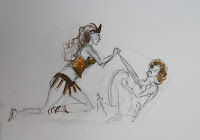
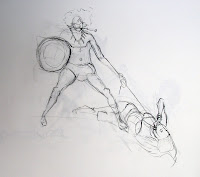
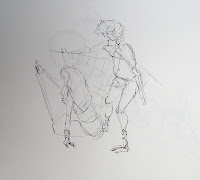
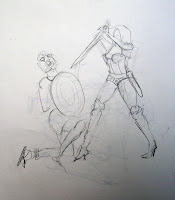
Karl Gnass said at his workshop on 2 Figure Composition that the most important thing in a drawing is the story. You can net it out like your paycheck.
Start a drawing out with long lines of action. Don't try to force one line - it's an artifical endeavor. You need a rhyth,oc relationship between lines that keep it as simple as possible.
UNITY - does not need to be harmonic - can be dissonate. Out of balance doesn't mean lack of unity.
HARMONY - too much harmony is stasis although it can represent the sublime - but it is not a good story. A story with absolute harmony means that there's not much happening. How compelling the struggle is. Homostasis. We don't care anymore until that moment there's an excitement of getting things back in balance.
HARMONY and BALANCE don't make it unfied. No unity - no picture.
Two figures need to be unified - need to find lines into the whole story.
POUSSIN may have a zillion figures in his paintings/drawings but they work as a whole - a physical unity - but there also may be an emotional element to it.
What you are drawing is an idea not just what you are seeing. This is what the CUBISTS were doing. They are depicting the physical - there's more than what you see with the eye.
Every point of view is a subjective point of view. Every choice you make is a choice. So then why not make an interesting choice. Don't use short cuts.
Remember long lines of action - remember the x,y and z axis.
Points attract us like bullseyes. Iconic work like Pre Renaiisance Art reflects the oriental aspect of art.
The Renaissance wants to get out of the square - thinks about golden section or the sweet spot. It is the difference between self reflection and taking a walk.
Don't change by exaggeration instead heighten the pose. Exaggeration for Karl Gnass is just style.
Think of
a. Lines (lines of action and direction)
b. Surface (surface has up and down, right and left, but it doesn't take us out)
c. Volume (unity, as well as, space)
Negative space has characterisitcs.
Michaelangelo's Last Judgement has Parralels on a different plane
TIMING
- think about if you had an artist set up the telephone poles in a city
- feel some things faster and some things slower
- figures on a stage with shifting movements
Giotto experimented with movemt
Look at greek and roman friezes and egyptian hieroglyphics
Start to feel movement not copying - use the figure as a point of departure
Be aware of the ground plane. We have an up side and then we have down and around.
- find movement and rhythm
- the more horizontal the figure is the more defeated the figure is
- work on an abstract level first
- have forward and back
- try not to have everything lined up on easy planees
- up and back on diagonal
Composition is more than design - it tells stories
Good design tells a story from a distance (simple, clear, grabs the eye)
Refine things in terms of their relationship to each other
Don't create tangents but instead tension relationships
Remember the relationship between the edge and another edge
Remember the sacred structure, sweet spot and the golden rectangle - Use them.
No comments:
Post a Comment
Thank you for your comment. It is much appreciated.
Namaste,
Nya